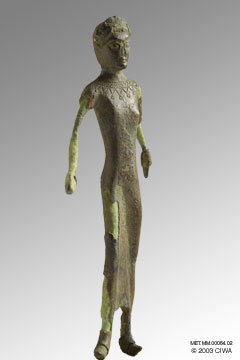Etruscan young woman, 570-550 BC

Links to other views:⇒ Larger View⇒ Back Left if scripting is off, click the ⇒ instead. Links to others of type Statuette-womanBronze female dancer, Rome, 200-27 BCBronze goddess Neith, Ptolemaic Period Bronze of a queen nursing, Dyn. 25 Bronze of Ceres, Rome, 200 BC-307 AD Bronze of Goddess Nebethetepet, Dyn. 12 Bronze of Mut, Ptolemaic Period Bronze Venus, Alexandria, 50 BC-50 AD Gilded statue of a queen, Early Dynastic Hathor as a woman, cow headed, N.K. Protodynastic female statuette, Dyn. 0 Queen Aqaluqa as Isis nursing, Dyn. 25 Queen as Goddess Mut, Dyn.18 Queen as Isis nursing, Dyn. 12 Queen as Isis nursing, Dyn. 25 Queen as Isis-Hathor nursing, Dyn. 21 Queen Hatshepsut as Goddess Mut, Dyn. 18 Queen Hatshepsut as Hathor, Dyn. 18 Queen Isis as Isis nursing Thutmose III Queen Isitnefret as Isis nursing, Dyn. 19 Queen Karama as Goddess Neith, Dyn. 22 Terracotta young woman, Greece, 450 BC Victory and Athena, terracotta, Greece Woman and girl, Tanagra, 340-300 BC Woman with elaborate headdress, Crete |
This silver-plated bronze statuette of an Etruscan kore (young woman) was made around 570-550 BC. She wears a diadem and a large circular necklace. The tunic appears to stretch down to the feet, where it meets the pointed soft shoe common in Etruria. Etruscans The Etruscan (or Tusci) civilization was a short-lived but original, sophisticated and influential civilization that developed in the region of northern Italy still known today as Tuscany. Following the Villanovian culture of the ninth century BC, the Etruscan culture emerged around 800 BC among the indigenous population, with perhaps some influence from the East. The Etruscan language is still poorly understood. Although the writing symbols are similar to the Greek alphabet, the words of the language are like no other. Although we speak of Etruria as if it were a nation, it was really no more than a set of cities and city-states with a common culture. Although Roman historians describe a “council” of twelve Etruscan cities, we have no idea what was the purview of the council, and there is little evidence left of any concrete political entity. With a long coastline rife with natural harbors, and a back country rich with copper and iron ore, Tuscany was well suited to the development of both technology and commerce. The Etruscans excelled in both. Etruscan art and techniques were greatly influenced by the Greek World, yet preserved their own distinctive character. At their heyday, Etruscan metal craftsmen had no equal anywhere in the ancient world, and their wares were highly prized all over the Mediterranean. Etruscans also excelled in public works. Despite their lack of a central government, they built a spectacular network of roads, bridges, and viaducts. They developed a clever system for improving the drainage of their lands and controlling the levels of their lakes. They also built remarkable cities, temples and tombs. Etruscans had a complex religion and a deep concern for the afterlife that led them to build chamber tombs, replicating underground the dwellings of the living. It is from those tombs, their decorated walls, and the vast amounts of material cultural goods (much of them imported) the tombs contain that we have learned most of what we know about Etruscans. Etruscan prosperity declined sharply during the fourth century, as other powers blocked their trade routes: southward with their complete naval defeat against the Greeks at Cumae in 474 BC on the Mediterranean side; northward with the progressive takeover of their outposts in northeastern Italy on the Adriatic. But in the long run it is Rome, a city-state of Latin people deeply influenced and infiltrated by Etruscan families at the highest levels of power, that would gradually absorb the cities of the Etruscan culture. By 100 BC, Etruria had become completely assimilated into the Roman world it had helped educate. Bibliography (for this item)Bianchi Bandinelli, Ranuccio, and Antonio Guiliano1973 Les étrusques et l’Italie avant Rome. Gallimard, Paris, France. Hus, Alain 1977 Dix siècles de bronze: l’âme étrusque et les séductions de l’Orient. Dossiers de l’Archéologie, 24:28-35. Moretti, Mario, Gugliemo Maetzke, Manuel Gasser, and Leonard Von Matt 1970 Art et civilisation des étrusques. Hachette, Paris, France. Münzen und Medaillen, 1986 Auktion 70. Kunswerke der Antike. Münzen und Medaillen, Basel, Swizerland. Bibliography (on Etruscans)Tait, Hugh1991 Jewelry: 7000 Years: An international History and Illustrated Survey from the Collections of the British Museum (republication of the 1987 edtion by H. N. Abrams). Abradale Press, New York, NY. |